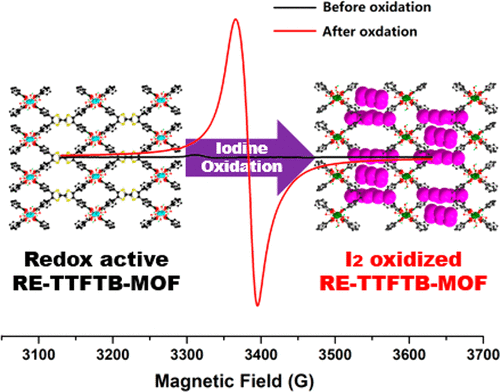当前位置:
X-MOL 学术
›
Inorg. Chem.
›
论文详情
Our official English website, www.x-mol.net, welcomes your
feedback! (Note: you will need to create a separate account there.)
Redox Activities of Metal–Organic Frameworks Incorporating Rare-Earth Metal Chains and Tetrathiafulvalene Linkers
Inorganic Chemistry ( IF 4.3 ) Pub Date : 2019-03-04 00:00:00 , DOI: 10.1021/acs.inorgchem.8b03299 Jian Su 1 , Tian-Hao Hu 1 , Ryuichi Murase 2 , Hai-Ying Wang 1 , Deanna M. D’Alessandro 2 , Mohamedally Kurmoo 3 , Jing-Lin Zuo 1
Inorganic Chemistry ( IF 4.3 ) Pub Date : 2019-03-04 00:00:00 , DOI: 10.1021/acs.inorgchem.8b03299 Jian Su 1 , Tian-Hao Hu 1 , Ryuichi Murase 2 , Hai-Ying Wang 1 , Deanna M. D’Alessandro 2 , Mohamedally Kurmoo 3 , Jing-Lin Zuo 1
Affiliation

|
Metal–organic frameworks (MOFs) incorporating lanthanide nodes and tetrathiafulvalene (TTF) linkers offer a viable approach for combining redox activity and magnetism in one material. Four rare-earth lanthanide ions (RE = Tb, Dy, Ho, and Er) were found to form isostructural MOFs consisting of metal chains bridged by redox-active tetrathiafulvalene-tetrabenzoate (TTFTB4–) whereby the carboxylate moieties act in both anti-anti and syn-syn coordination modes. These materials display tunable redox-active properties and slow magnetic relaxation phenomenon (Er and Dy). While the as-synthesized crystals contain the neutral diamagnetic TTF moiety, using either a solid-solution electrochemical method or iodine oxidation transforms part of the latter to the paramagnetic TTF•+ radical in a single-crystal-to-single-crystal manner without altering the internal structure of the building chains and the frameworks. This is accompanied by inclusion of I3– replacing some of the solvents, as well as changes in the central C–C bond length of TTFTB, a strong EPR response at g ∼ 2, and an enhancement of the reflectance at low energies originating from absorption by the radical.
中文翻译:

结合稀土金属链和四硫富瓦烯键的金属有机骨架的氧化还原活性
包含镧系元素节点和四硫富瓦烯(TTF)接头的金属有机框架(MOF)提供了一种在一种材料中结合氧化还原活性和磁性的可行方法。四稀土镧系元素离子(RE = Tb时,镝,钬,和Er)被发现,以形成同构的MOF自由金属链桥接由氧化还原活性硫富瓦烯-四苯甲酸(TTFTB 4-),由此羧酸盐部分在这两个作用的抗-防和SYN - SYN协调模式。这些材料显示出可调节的氧化还原活性和缓慢的磁弛豫现象(Er和Dy)。合成后的晶体包含中性的反磁性TTF部分时,使用固溶电化学方法或碘氧化法,可以将其一部分以单晶至单晶的方式转变为顺磁性TTF •+自由基,而无需改变建筑链的内部结构和框架。这伴随着通过包含第I 3 -代替一些溶剂,以及改变在TTFTB,在强EPR响应的中心C-C键长克〜2,在从低能量始发的反射率的增强被自由基吸收。
更新日期:2019-03-04
中文翻译:

结合稀土金属链和四硫富瓦烯键的金属有机骨架的氧化还原活性
包含镧系元素节点和四硫富瓦烯(TTF)接头的金属有机框架(MOF)提供了一种在一种材料中结合氧化还原活性和磁性的可行方法。四稀土镧系元素离子(RE = Tb时,镝,钬,和Er)被发现,以形成同构的MOF自由金属链桥接由氧化还原活性硫富瓦烯-四苯甲酸(TTFTB 4-),由此羧酸盐部分在这两个作用的抗-防和SYN - SYN协调模式。这些材料显示出可调节的氧化还原活性和缓慢的磁弛豫现象(Er和Dy)。合成后的晶体包含中性的反磁性TTF部分时,使用固溶电化学方法或碘氧化法,可以将其一部分以单晶至单晶的方式转变为顺磁性TTF •+自由基,而无需改变建筑链的内部结构和框架。这伴随着通过包含第I 3 -代替一些溶剂,以及改变在TTFTB,在强EPR响应的中心C-C键长克〜2,在从低能量始发的反射率的增强被自由基吸收。


















































 京公网安备 11010802027423号
京公网安备 11010802027423号